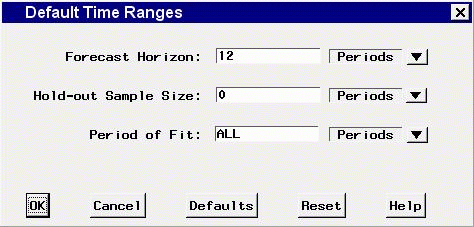Default Time Ranges Window
Use the Default Time Ranges window to control how the period of fit and
evaluation and the forecasting horizon are determined for each series when you
do not explicitly set these ranges for a particular series. Invoke this window
from the Options pull-down menu of the Develop Models,
Automatic Model Fitting, Produce Forecasts, and Manage Forecasting Project
windows. The settings you make in this window affect subsequently selected
series: They do not alter the time ranges of series you have already
selected.

Controls and Fields
- Forecast Horizon
-
specifies the forecast horizon as either
a number of periods or years from the last nonmissing data value
or as a fixed date.
You can type a number or date value in this field.
Date value must be entered in a form recognized by a SAS date informat.
(Refer to SAS Language Reference for information on SAS date informats.)
- Forecast Horizon Units
-
indicates whether the value in the forecast horizon field
represents periods or years or a date. Click the arrow and
choose one of these three options from the popup list.
- Hold-out Sample Size
-
specifies that a number of observations, number of years,
or percent of the data at the end of the data range be used
for the period of evaluation with
the remainder of data used as the period of fit.
- Hold-out Sample Size Units
-
indicates whether the hold-out sample size
represents periods or years or percent of data range.
- Period of Fit
-
specifies how much of the data range for a series
is to be used as the period of fit for models fit to the series.
ALL indicates that all the available data is used.
You can specify a number of periods, number of years,
or a fixed date, depending on the value of the units field to the right.
When you specify a date,
the start of the period of fit is the specified date or the
first nonmissing series value, whichever is more recent.
Date value must be entered in a form recognized by a SAS date informat.
(Refer to SAS Language Reference for information on SAS date informats.)
When you specify the number of periods or years,
the start of the period of fit is computed as the date that number
of periods or years from the end of the data.
- Period of Fit Units
-
indicates whether the period of fit value
represents periods or years or a date.
- OK
-
closes the window and stores the specified changes.
- Cancel
-
closes the window without saving changes.
Any options you specified are lost.
- Defaults
-
resets all options to their default values.
- Reset
-
resets the options to their initial values upon entry to the window.
Copyright © 1999 by SAS Institute Inc., Cary, NC, USA. All rights reserved.
